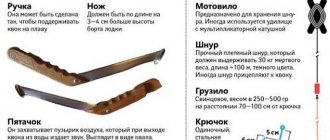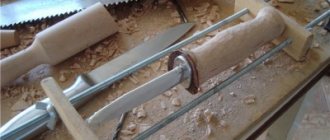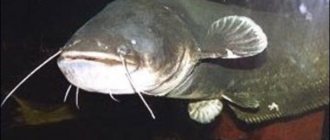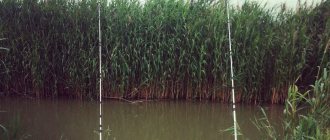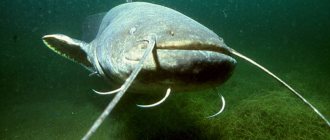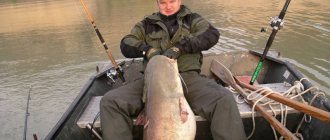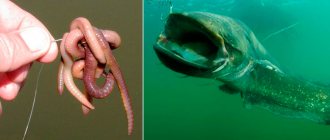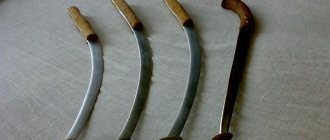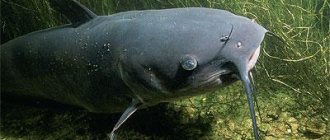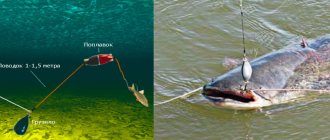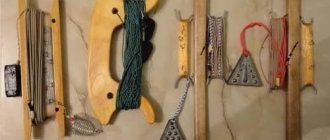Catching catfish using kwok. How it all started
Several years ago we had a catfish boom on the Volga and Kama. Catching catfish using kwok has become very popular. The gear sold out in local stores with a bang. People bought expensive echo sounders specifically for this fish. Handmade quacks were ordered weeks in advance. Everybody caught catfish, or rather tried to catch it. As it turned out, finding his camp site turned out to be much easier than forcing this predator to take bait. Fishermen saw it in the echo sounder, but could not catch it.
The whole beauty of catfish fishing with an echo sounder lies in its entertainment. You clearly see the fish on the device screen and try to force it to bite. If it weren’t for the echo sounder, we could have gone to another point a long time ago. But the alluring screen with a real picture makes you try again and again to slip the bait under the nose of the predator. Here he rises from the bottom, now he approaches the bait, which is also visible on the echo sounder, but does not take it. Eh, what a shame.
And you again work as a kwok, calling this predator to you. If luck smiles and there is contact, then you give a few seconds so that the catfish swallows the bait well and sharply hooks it. The muscles are tense, adrenaline rushes into the blood. You feel someone struggling at the other end of the tackle. You experience an unforgettable feeling when catching catfish with a kwok.
Tactics and techniques for catching catfish using kwok
Buying a good quok and choosing reliable equipment is not the entire list of conditions for achieving results. To find fish, it is better to use an echo sounder, and then the sounds made by the quok will force it to react to the bait.
In windy weather, working with a kwok with a small heel is inconvenient; the sound is not at all what it should be. In such cases, use a quok with a wide heel.
Somyat fishermen float out on a boat and when they discover a promising place, they stop and fish for it. They cluck with a series of blows (3-5), after each they make a pause (1-2 minutes). If the catfish finds the bait, a bite follows and all that remains is to pick up the fish and bring it into the landing net.
Even if you don’t immediately manage to catch a trophy catfish using a quok, you need to improve the technique of working with this tool and luck will definitely come in the form of an excellent catch.
How to set up an echo sounder for catching catfish using a kwok
An echo sounder for catching catfish with a kwok does not have to be expensive. Of course, the expensive one is better, but to see the bait and fish, the simplest model is enough. I use a regular black and white single-beam echo sounder like this one from Aliexpress (link will open in a new window). But no matter which model you use, their settings will be approximately the same, since we mainly work with two parameters: “sensitivity” and “depth range”.
The first thing we need to do is remove the function that displays fish as symbols (fish icons) and set the display mode to arcs. Then you need to adjust the depth correctly. The echo sounder has a “depth range” parameter. For example, from 0 to 5 meters, from 5 to 10 meters and so on. So, you need to adjust the closest depth value at the fishing spot.
If you fish at 12 meters, then set it to 15 or 20 meters, depending on how the scale in your echo sounder is divided. If we stand at 8 meters, then we set it to 10 meters. This is necessary so that the echo sounder operates at the minimum signal emission power for a given depth and scares off fish less with radiation.
Living creatures sense impulses emanating from the echo sounder sensor. Therefore, the lower the power of these signals, the better.
Next we will work with the “sensitivity” parameter. If you set it too much, then all the interference will be visible: any bubbles and pieces of algae in the water. If you set it too low, the bait will not be visible. Therefore, we lower our bait a meter from the bottom and set the sensitivity so that the bait is reflected on the device screen. It will appear as a solid line on the screen. All is ready. Now let's talk about bait and how to get it.
Fishing technique
It’s worth going together to catch catfish using kwok. If a large catfish bites, it is almost impossible to pull it out alone, so we bait the tackle and lower it to a depth of 5-7 meters. Under no circumstances should we wrap fishing line around our hand. If a large catfish bites, it can drag you away. Next, we begin to squawk, make three sharp blows and pause for 20 seconds. We immerse the quok no more than 10 cm in water. If there is no bite at a promising place, be sure to return to this place a little later and try again.
As soon as the catfish hears the sound of a quok, it rises up and meets the bait on its way. He grabs it and goes into the depths, this is a bite. More precisely, it just pulls down and that’s it. Next, we take a short pause, allowing him to swallow the bait more forcefully, and sharply hook him. We make a sharp but short hook.
A large catfish can bite with a very strong jerk, you need to be prepared for this so as not to pull the tackle.
After hooking, we release the catfish, and then begin to fish it out. It all depends on the size of the fish caught. If it’s 10-15 kg, then feel free to pull it out, if it’s larger, then let it get tired and only then pull it out.
How to catch a crawler for catching catfish using a quok
Catfish are omnivores, so they are caught on a wide variety of baits. Among them: locusts, chafer larvae, mole crickets, scorched carcasses of sparrows, frogs, bird liver, squid, crayfish necks, barley shells, fish fry (live bait). In different regions, catfish are caught with different baits. In the Kuibyshev Reservoir and on the Kama, the most common bait for catfish is the crawler.
Unlike an ordinary earthworm, they do not dig it, but hunt it. This method is quite exciting and somewhat reminiscent of fishing. Let me tell you in more detail how I get this bait.
The crawl is a huge worm more than 20 centimeters in length. He's fat and juicy. Just what a hungry catfish needs. The crawlers emerge to the surface under the cover of darkness and onto moist soil. The rest of the time they sit in their burrows deep underground. Therefore, you need to wait for rain, or water the soil in the garden abundantly before the upcoming hunt.
As soon as it gets dark, the crawlies will begin to crawl out and stretch out along the ground. But catching them is not so easy. The worm's tail is always in the hole and as soon as the crawling gets scared, it disappears into its house in a split second. Therefore, we take a very weak flashlight with a dim light, so as not to scare away the coward and the construction glove. We walk through the garden and look for bait. Did you see the crawl? Now we slowly bring our hand up and grab his head.
If the crawler was in a hole, then it will stay in it with its lower body. How it is held there and what prevents it from getting out, I cannot judge, but do not rush to take it out - it will tear. Just hold it there for 5-10 seconds and it will loosen the muscles.
Then the crawl can be safely pulled out and the hunt can continue. Thus, in an hour you can easily collect up to a hundred fat worms.
Technically, the process of catching catfish with a kwok is as follows:
After the quok is taken in hand, lower the bait on the hook under water. Depending on the depth, we measure the length of the cord, and most often it is about 4 meters. After this, we make slaps on the water with a quok. The blow is made perpendicular to the surface of the water, and the snout follows a route under water in the form of an arc. The hand should not be tense. This disrupts the functioning of the kwok and leads to rapid fatigue.
The sound of the quok is affected by the size of the patch. The small snout produces a louder sound. You need to have several quoks with different cup-patch sizes in stock. If on calm water a small snout sounds loud and ringing, then on ripples and waves it will not work well. Here you need a kwok with a larger cup. Usually there are 3 kwoka strikes, followed by a pause.
How to make a kwok quickly
How to make a quok with your own hands for catching catfish, simply and quickly. I'll tell you now.
It is not known for certain why the catfish reacts to sounds produced with the help of a quok. There are many opinions on this matter on the Internet, but I am not inclined to any particular point of view. It’s enough for me to know that it works, and let scientists figure out why. Our task is to catch catfish with a quok.
A good kwok from a renowned master is not cheap. In fact, it is the same instrument in the hands of a fisherman, like any musical instrument in a musician. The catch depends on the correct quok and its skillful use. But my experiments showed that a kwok can be made from scrap materials for pennies and it will also work.
This is evidenced by 4 different quokkas that I made literally on my knees and all of them brought me more than one catfish. The largest catfish in my life was 15 kilograms, but mostly these are 7-9 kilogram specimens. But it’s also quite difficult to fish them out alone, sitting in a small inflatable boat. So, all my quotes turned out to be working and are easy to do.
Kwok from a coin
I didn’t spend too much time fiddling with the precise angles at which the snout should be located relative to the body, or as it’s called the Kwoka knife. My task was to do it quickly, try the kwok in work, and then experiment. I took an old ruble coin from the USSR era. I drilled a longitudinal hole in it and cleaned it with a file. Then I cut out a kwok knife from an old piece of duralumin. He inserted a coin and riveted it. I cleaned the base with sandpaper.
To prevent the quok from sinking, the handle was made from ordinary insulation. This is extruded polystyrene foam - a durable foam that is used to insulate houses. It can be easily processed with a knife. I wrapped the handle with electrical tape. It took me less than an hour to make the first quok. Using the same principle, I made several more, but with a different shape of the snouts to make different sounds on the water. Let's experiment. There is nothing difficult to make, but learning how to extract the correct buns will be more difficult.
In fairness, it must be said that I had the opportunity to work with expensive quokkas from craftsmen, made of titanium and noble wood species. They all worked, but my regular aluminum fishing rods also brought me catches. For myself, I concluded that it is not the quok that catches catfish, but the ability to use it. Even if it’s just an ordinary soup spoon, it can also make sounds.
How to feed catfish
The following are suitable baits when catching catfish using a quok:
- crustaceans,
- frogs,
- squid,
- worms,
- locust,
- gudgeon.
Bait is an equally important element in fishing. To do this, you should feed the future fishing spot in advance, about half an hour in advance, and in such quantities as not to overfeed the fish. After this, you can start catching the mustachioed giant.
Since catfish are found in the upper and lower reaches of the Kama River, you should not look for it in shallow and cold water bodies.
It should be noted that the mustachioed giant cannot stand sunlight and tries to find more intimate places in the pond.
Evening time is the most convenient for catfish, as it begins to hunt for food.
How to work with a kwok
On the Internet you can watch many videos on how to work with kwok correctly. Here is one of such videos. The video will open directly in the article
It's hard to describe this process in words, you have to try it. Your task is to grab the air bubble with the heel of the quok and drag it under water. When the bubble comes to the surface, it will collapse and make a sound. For some it happens faster, for others it takes longer. It took me about an hour to get the correct sound on 8 out of 10 beats. I trained in the bay from an inflatable boat and in a large barrel in the garden.
Some anglers believe that it is better to catch catfish from an inflatable boat, since the iron hull scares away this predator. But I have many friends who successfully hatch catfish from aluminum Kazankas. So, those who catch do not believe in these moments regarding the fact that catfish are repelled by metal. The main thing here is to catch, and when you don’t catch there are always many reasons.
Kwok fishing tackle
In order to catch catfish, it is enough to take reliable tackle and a rope with a diameter of 4.5 mm. A lead sinker is attached to such a rope. A meter away from him there is a tee with bait.
Among modern gear, it is worth choosing a fiberglass spinning rod, which has a power multiplier and braided fishing line.
If fishing takes place on a river, then you can use simpler gear. So, you can take a homemade fishing rod that has a spear at the end. An inertial reel with fishing line, the diameter of which is 2.5 mm, is installed on it. A tee and a sinker weighing 200 g are attached to the fishing line. The tee is attached using a nylon leash. The heavy weight of the sinker allows you to hold the equipment in a certain place.
You can also use a fishing rod and a durable marine-type reel to catch catfish. The fishing line used must be at least 60 m long. It must easily withstand a load of several tens of kilograms. To make the process of getting fish easier, you should have a landing net with you.
Cutting edge for catching catfish
Catching catfish with a kwok is not only a kwok. If you plan to constantly engage in catfish fishing, then over time you will need to purchase a special power rod, a powerful reel and braided cord. These tackles will make the fishing process much easier. But first, you can collect the edge. This is the simplest tackle that is used not only by beginners, but also by experienced fishermen. There are even fishermen who would never trade a cutting edge for a fancy fishing rod. To each his own. The edge does not take up much space and is quite reliable.
What is a cut?
So, what is tackle? The edge is a wooden reel on which a rope-cord with a diameter of 2-4 mm is wound. Such cords can be purchased at fishing and construction stores. 30 meters will be enough. Next you need a swivel that can withstand heavy loads. In my photo it’s 40 kg to break. The leash can be a thick line up to 1 mm, or a twist of several thin lines.
But, in my opinion, the best option is soft, durable braid. Of course, a braided cord can quickly be rubbed by catfish teeth, which are like fine iron bristles. But with small catfish I had no problems in this regard. But the braid is soft and the fish do not feel it when testing the bait. The leash itself is about 1.5 meters long.
A heavy lead weight hangs above the leash. You can buy it or cast it yourself. The weight of the load is selected relative to the current. The load must be under the boat within the range of visibility of the echo sounder sensor and not being carried away by the draft. The weight is put on a rope through a through hole and fixed. Some fishermen wrap the load with electrical tape. It is believed that this way the catfish feels the metal less and approaches the bait more boldly. I can’t say for sure whether this is true. I have edges both with closed loads and with open ones and there was a bite on each one.
Sometimes such cargo is hidden in the body of a large silicone squid, which is used in sea fishing. This decoy serves to attract a curious catfish. A large spot of straightened tentacles can be seen in the water from afar, and already underneath it hangs an appetizing bait.
Catching catfish with kwok requires sharp and strong hooks. I use Japanese ones. They are expensive, but it is justified in catfish fishing. On the same Aliexpress, it is now not a problem to buy catfish hooks (link will open in a new window). You can fish with a single hook, with a double hook, or with a tee like the one in the photo. It is very convenient to put on a bunch of crawlers and other soft bait.
Catfish fishing gear
You can catch catfish using a variety of gear - from expensive branded fishing rods to cheap homemade gear:
Equipped anglers can try their luck at trolling. To do this, you will need a boat with a motor, a high-quality spinning rod, an echo sounder and deep-sea wobblers or heavy large spoons. It is better to first walk over the edges and holes.
If there is no boat, then ordinary hooks will be used, consisting of a thick fishing line, a sinker and a leash with a tee hook. The tackle can be thrown into a pond either using a spinning rod with a reel or by hand. You need to unwind the fishing line from the reel and, spinning the weight above your head, throw it together with the bait into the water.
Fishing with kwok
There are many options, but the best way to fish for catfish is with a kwok. This is a special device that is used to splash on the water while moving over the holes in a flotation device. At the same time, the quok emits a specific squelching sound, forcing the lazy predator to leave its home and rise to the surface of the water, where a pre-prepared bait awaits it.
It is still unknown exactly why the catfish reacts so inadequately to the squelching of a piece of wood in the water, but the fact remains that most often the catfish is caught by quok.
Catching catfish using kwok:
Lures for catching catfish
In the fall, catfish are most often caught using the following artificial and animal baits:
- large wobblers capable of diving to great depths, heavy wide spoons, large vibrating tails;
- a bunch of crawling worms;
- shell meat;
- live bait or pieces of fresh fish;
- crayfish;
- frogs;
- chicken giblets or skin.
In different places and at different times, the most catchy baits for catfish can be completely different baits.
Water anchor or parachute for catching catfish
This important attribute is very helpful, especially in windy weather. A water anchor is needed to slow down the boat during rafting. The speed of a boat with a parachute drops considerably. By tying the anchor to different places on the boat, you can set a comfortable position for the vessel in which it is comfortable to nod.
When you float slowly, you can carefully fish a promising place and conveniently monitor the bait on the echo sounder screen. There are many options on the Internet on how to make such a parachute. I took the simplest route and did the following. I made a semblance of a quadrangular pyramid from large bags, with a hole at the base. There is an iron rod through the bottom and it sinks. There is a wooden stick at the top, and an empty plastic bottle is tied above it, which acts as a float.
When it gets into water, the structure straightens out as in the photo. It turns out to be an underwater parachute. It is attached to the boat at a distance of several meters and slows down the rafting speed. If you plan to constantly catch catfish, then you need a water anchor. This is what it looks like in the factory version (link will open in a new window)
Fishing equipment
The design of the gear is similar to the design of the old gear using a cow's horn. Only in our time, instead of twine, strong nylon cords or braid with a diameter of about 2 mm are used. The cord is passed through a hole drilled in the upper part of the handle of the quok and is the main line of the tackle, the supply of which can be up to 50 m and the cord is located on a strong, voluminous reel. A leash about 1.5 m long made of durable and thick braid is tied to the cord. The hook chosen is single, the largest, No. 20-36. The size of the hook depends on the size of the predators living in a given area of the reservoir. It is best to dye the nylon cord to match the color of the water. The braid should also be selected in protective colors, that is, green or blue.
A heavy sliding sinker is usually attached to the main line, which can pull the thick line into a straight line and drag the bait to the depths. But equipment is not the most important factor in success in catching catfish. The fishing technique is very important, that is, the correct operation of the quok, the sounds of which often determine whether a predator will approach or, rather, move away. The best way to gain experience in catching catfish using a kwok is not from videos, photographs and articles, but from a seasoned catfish, being in the same boat with him.
In the work of the quok, the moment of immersion of the cup-piglet into the water is very important, and the process of its passage under the surface of the river is no less important. With the correct technique, while the quok snout is in the water, an air bubble forms on the surface of the river. When this bubble bursts, the sound can be heard hundreds of meters away. And the bubble is formed from atmospheric air captured by a cup of quok and introduced into the water.
Where to look for catfish when fishing with kwok
Catching catfish with a quok is also possible on small rivers with depths of 5-7 meters, but I fish on such large rivers as the Volga and Kama. If you have an echo sounder, identifying a promising place is not so difficult. Usually these are deep channel holes. Catfish can also rest right under a steep bank, where there are deep waters. Now catfish are already accustomed to water transport and are not afraid of the noise of propellers from motor ships and barges. I often caught catfish several tens of meters from the shipping channel. A ship passes, and after some time a bite follows.
That is, on an unfamiliar body of water we look for a hole and float over it, working with a kwok. If there is a catfish, it will definitely show itself on the echo sounder screen. Moreover, this is usually visible already in the first minutes of the beginning of nodding. If you wait an hour and there is no fish in sight, then there is a high probability that there is simply no fish in this hole.
I managed to catch catfish on a flat bottom with depths of up to 7-8 meters. But rather these were exceptions. Larger numbers of this barbel were always caught over the pits. My friends managed to hook large catfish weighing from 25 to 35 kg on a jig head when fishing for pike perch using a spinning rod. Moreover, the depths where these specimens were caught were less than 4 meters. But you need to understand that at such depths it is not possible to catch catfish using a kwok from a boat. It just won't fit.
Where to look for catfish
Catfish is a predator that always has its favorite places, so experienced catfishers can always easily identify a promising place for fishing. The more experience, the more knowledge, and, accordingly, the greater the catch.
The very first place you should try to catch catfish is a hole! Any hole, the deeper the better, is a very promising area for catching catfish. Usually, each catfish has its own hole. Smaller individuals up to 3-4 kg can share one pit among themselves, forming colonies of 2-5 small catfish.
But pits are far from the only place where catfish can be found and hunt. Any terrain or shelter in which the catfish can hide from the current can serve as promising places for catching a mustache with a quok:
- behind the bridge pilings;
- in river rapids and ledges;
- at river turns, sticking to the side where the current is less;
- in the bays;
- behind breakwaters, etc.
However, you should not look for areas without any current at all; fishing there with quok will not bring much results. In addition, the catfish loves snags very much, almost like carp, and also often hides under trees and thickets of water lilies hanging over the water. And when the water rises, it can reach smaller areas of the reservoir. Catfish can also go out into shallow water at night; in search of food, they can come quite close to the shore.
Best time to catch catfish
Catching catfish using kwok is limited to a certain season. Catfish is a heat-loving predator. In winter, it sleeps in suspended animation in wintering pits. Only when the water warms up does it become active and begin to feed intensively. In our latitudes, the optimal time for catching catfish with kwok is summer. In some places, catfish bite even in September, while the water is still quite warm. But the greatest activity of this fish, when it can be caught with kwok, is in the summer months.
As for the best time of day to catch catfish, I can’t give a definite answer. If you start looking for this information on the Internet, you may come across articles where they write that catching catfish with a kwok is better at dawn or dusk, since predatory fish usually feed actively at night and hide from the sun during the day. But my personal experience has shown that catfish can be caught at any time of the day.
Of course, it is better not to do this on the river in complete darkness and follow safety rules. But during the day, catfish are caught no worse than in the morning or evening. I often went out to catch catfish after 10 a.m. and returned with my catch at lunchtime. Even high temperatures and bright sun did not bother this fish. So experiment on your rivers and you will understand when the best time to catch catfish is in your area.
How many shells do you need for catfish fishing from a boat?
Being in the middle of the river in a boat, you cannot get a new shell for bait. An acquaintance of mine, who is fond of fishing for kwok, collects a twenty-liter bucket of shells, from which an incomplete five-liter pot of shell meat will be obtained. The supply of bait should be large; the shell is eaten by both bream and small catfish and other fish.
ADVICE – IT’S GOOD IF THE COLLECTED SHELL GOES A LITTLE BIT GOOD
see the post DOING YOUR HANDS FROM APRICOT
Catfish are caught very well using a leech. More often, catfish are caught on docks from the shore using a leech, including using quok. You can fish with leech and quocha from a boat.
The leech is placed on a hook in the following ways:
- Just pull the beam of a large leech in three or two places with a braided line. A large leech is pulled in the middle, near the trunk, near the sucker. They tighten it twice, squeezing the braid with force, but so as not to cut the leech, and also making a double knot. The hook is threaded through the braid (between the braid and the leech), and the leech is not damaged and lives longer. Such bait will constantly move in the water (spin and crawl) and attract catfish and other fish. I tie a small leech once in the middle. Sometimes they bandage it in two places in the middle and near the sucker. When the catfish takes such bait, the hook will be in its mouth.
- The leech is also placed directly on the hook, usually threaded in two places. In this case, it is imperative to cut off or cut the leech’s sucker, otherwise it will wrap around the hook and the catfish will not be hooked. You can also cut off the leech's tail. Proponents of snipping a leech claim that the blood (smell of blood) of the leech will attract catfish. But in our opinion, the first method is better.
SEE ENTRY BLACK LEECHES – FISHING BAIT
Of course, you can fish with a leech and a shell both from the shore and from a boat and without a quok.
- Selecting a quok, buying a quok without checking. HOW TO CHOOSE AND BUY KUK SEE RECORD Do-it-yourself apricot kok
- The ability to quack, and select the quack according to the height of the boat.
- Hooking only after a sharp jerk of the catfish.
- Choice of location, catfish prefer pits.
- Choosing bait and ensuring a supply of bait for the entire fishing trip.
Catching catfish with a quok from a boat will be successful if you take these main points into account. This kind of fishing requires good preparation.
Catching catfish using kwok. First try
Well, we've come to the most interesting part. Catching catfish with a quok and my first attempt. For the first time, we decided to go alone with our partner. Each of us had our own quok with a different sound. We went to the middle of the Volga and found a promising hole about 15 meters deep. The hole was long, and it was possible to float over it for a long time, challenging the catfish to a fight. The west wind drove us downstream.
We threw a water parachute and began rafting. One edge was set so that the bait was a meter from the bottom, the second was three meters higher. We started working as a kwok. To my surprise, catfish rises immediately appeared on the echo sounder. It looked like a thick line that came off the bottom and came back again before reaching the bait. The presence of fish right under our noses gave us no rest.
We tried playing with different hooks, but there were no bites. So we reached the end of the pit. In an hour there were many catfish rises, but not a single bite. It was decided to return to the beginning and sail along this route again. The second pass was equally unsuccessful, and we went a third time. And then my partner felt something. He waited for a few bites and made the hook. There was someone at the other end of the river.
And here he is our first catfish. It was a baby weighing less than 3 kg. Naturally, we sent him back. But the very fact that we managed to catch catfish using homemade quoks made us very happy. This means the method works.
Catching catfish on a shell
You can catch catfish:
- for spinning, both trolling and from the shore using spinners and wobblers
- on donks, feeders both from the shore and from the boat
How to squat from the shore
Kwok can be used for all types of catfish fishing:
- You can also fish with a hook from the shore (fishing from the shore) . Very often, when those fishing for quok swim by, catfish take the donkeys installed from the shore. The way to catch catfish from the shore is to use donks with strong hooks and fishing line and bait with a shell or leech. Having entered knee-deep water, they cluck in the area where the bait is laid and also move 10 meters to the sides. In the summer, you can even put a chair in the water to snorkel from the shore. In cold weather, boots or a suit are needed. You can also boat from a boat tied near the shore.
- Forging is also used when fishing by trolling (on the track). While leading the wobbler behind the boat, they simultaneously hit the water with a wok. This way you can circle around one attractive place on the river for catching catfish.
- They also use quok when catching catfish using a shell from a boat.
There are two ways to catch quok directly from a boat:
- drifting with the current on a boat over the pit and quacha
- anchored above a hole, this method is more successful
To catch catfish using a shell on a fishing rod, it is necessary to have an echo sounder, and an echo sounder is only needed to determine the location of holes on the river.
You need to learn the quok technique; if you take a catchy quok for the first time and try to catch a catfish, nothing will work. You need to study for more than one month. You can start with a bath, fill the bathtub with water and try to work with a kwok. You can learn to croak while sitting on a boat near the shore.
Under natural conditions, the catfish feeds by grinding barley shells , and it does not need to chase the shell; the catfish also hunts fish, crayfish, frogs, small animals and birds.
The best bait for catching catfish is a barley shell . Place 5-7 shells on a large hook so that the entire hook is covered.
Catfish are caught well on live crayfish . A live crayfish is attached to a hook with rubber bands for money; the body must be attached separately and, for reliability, pliers separately.
On the bottoms of the shore, catfish are caught well using a leech.
Catfish can also be caught with a bunch of worms using a bottom hook from the shore.
You can find descriptions of other baits, but let’s say you can always get a toothless shell on the river.
Using an echo sounder, a promising hole on the river is determined from 3 to 20 meters. They anchor upstream near the hole. The tackle is thrown 5 meters downstream.
Tackle for catching catfish
The main cord is braided 0.6 - 0.8 mm, the leash is 0.8 mm, the length of the leash is 40 cm. The leash is attached to the main cord through a swivel. You can place two hooks on the leash at a distance of 10 cm from each other. A sliding sinker of 100 g is attached to the main cord. The rod and reel must be adequately strong; it is better to take a powerful trolling rod and a multiplier (they can cast bait 5 meters), but you can use a cheaper inertial reel and an inexpensive crocodile-type rod. The hooks used are powerful.
catfish hooks
SHARE WITH YOUR FRIENDS, ADD ONE-CLASS ASSNIKOV TO YOUR FEED, TO YOUR WALL IN CONTACT...
Catching catfish with a quok while anchored
All comes with experience. I went on most of my subsequent fishing trips alone and honed my skills. Fish weighing 6-9-12 kg began to appear in my catches. My biggest catfish is 15 kilograms. The catches were stable, and I already knew exactly where to go and how to get catfish. There were times when I was expecting guests in the evening and could go for lunch for a couple of hours, catch a catfish at a barbecue and return.
I already knew with a high degree of probability that I would catch him. By the way, you need to grab the catfish by the lower lip, and a suede welding glove turned out to be very convenient for this. It is durable enough not to get hurt. And they are not that expensive. Take note.
Take a tranquilizer with you
And further. Be sure to keep a fish tranquilizer with you in your boat. This could be a wooden mallet, which must be used to accurately hit the catfish on the head and put it to sleep. Even a small catfish can cause a big commotion in your boat. Keep this in mind and be especially careful with hooks.
Over time, I began to try to catch catfish by anchoring in a hole. It is believed that this is not as promising as fishing with moving bait. Indeed, when the bait floats, the catfish grabs it more willingly. But when there was a current, I got used to catching catfish while standing at anchor. I stood up to exit the pit. For example, a hole is 17 meters, then I stand at 14 meters. I keep the bait a meter from the bottom and work intensively with the quok. Five beats, pause up to a minute, and so on. The bait itself sometimes had to be raised and lowered depending on where the catfish surfaced. And it worked.
For a while I abandoned the spinning rod, feeder and float and went exclusively for catfish on weekends. But as it usually happens, all my points were noticed by other anglers, and over time more and more people appeared on them. We had to swim further and further in search of secluded fishing.
Today I go catfish fishing less often – 3-4 times per season. After the unimaginable release of water in the Volga in the spring of 2021, fishing is no longer the same. Then a lot of fish and caviar died. There are fewer and fewer fish, more and more people, and even huge fines have been introduced. Inspecting authorities are increasingly coming up to you on the water and asking you to show your catch. You have to travel further and further in search of solitude and merging with nature.
When to catch catfish using kwok
The catfish wakes up after hibernation as soon as the water temperature rises above +5 °C and the more the water warms up, the more active the predator will be. The most noticeable surge in catfish activity is observed after the baleen spawning, which takes place around May and can be shifted depending on the fishing region and water temperature. To start spawning, the water must warm up to at least 15 °C.
The catfishing season ends already in October-November, since with cold snaps the activity of the catfish sharply decreases and the catfish begins to plunge into winter hibernation, from which it will wake up next year.
As for the time of day at which it is better to catch catfish, it is certainly best to catch catfish at night, but during the day its bites also do not stop and it is often caught on a quok during daylight hours. Also, the activity of catfish by time of day greatly depends on the season. In summer, catfish are reluctant to bite during the day, especially in hot weather, but in autumn, the activity of the baleen can practically not decrease around the clock.
Catfish go hunting at dusk! At this time, he is looking for suitable prey - fish, frogs, pearl barley, worms, leeches, etc.
If you are not an experienced fisherman and do not know the reservoir well, then it is better to practice catching catfish with a quack during daylight hours, while experienced fishermen can continue to “quack” day and night. The first time you try fishing for quok, it’s better to learn in the light, and at night, moor to the shore and try to catch the river giant on a bottom from the shore.
What to cook from catfish. Cold smoked catfish
Catching catfish with kwok is not only the fishing itself, but also the process of preparing the catch. Catfish fish is delicious. You can prepare different dishes from it. Boil the fish soup, make a shish kebab. Here you don’t even have to come up with any fancy recipes. Even if you just salt a piece of catfish and fry it on coals, it will be excellent. I love making cold smoked catfish. I have a simple smoke generator that I made myself. I'll leave the link at the end of the article. I use this smoke generator to smoke fish and meat. I use fruit tree chips. Cherry, apple or pear.
But before you smoke the fish, you need to prepare it well. This process takes me at least 20 days. And that's why. River fish are infested with parasites. You can eat it, but you need to process the catch well. Fry thoroughly so that there are no raw spots left and salt thoroughly. Many entrepreneurs, in pursuit of profit, salt fish for sale in small quantities of salt and for few days. Therefore, I never buy dried fish in stores.
I myself salt any river fish, regardless of size, as follows. For 3 kg of fish, at least 1 kg of salt, and more is possible. I stuff it into the gills, into the mouth, into the gutted belly. So it salts for three weeks. During this time, I turn the fish over and change places so that it is salted through and becomes like salt itself. Next, I soak it in running water for as many hours as the number of days it was salted. If there is no running water, then you need to change the water every couple of hours. Thus, we kill parasites with salt, and then drive out the salt with water. The fish tastes normal and is safe.
Next, I let the carcasses dry for a day in the breeze and smoke them for 10 hours in a cold-smoked smokehouse. After this I hang it out for a few days for final drying. The taste is amazing and the product is safe.
Preparing gear
Catfish is a large river predator whose weight exceeds 100 kg. Therefore, you should not expect softness or compliance from him. The gear should also be more prepared. For example, it’s a good idea if your (necessarily powerful) rod is made of fiberglass, composite or metal, with reinforced guides.
Swivels, clasps and other accessories should also be reinforced, capable of withstanding a powerful jerk. The same goes for the reel. It can be inertial; multiplex is good. It is better to use fishing line in the form of a braided cord - it is stronger.
3 methods of catching catfish are widely used:
- on the donk;
- for spinning;
- on kwok.
The last method sounds quite exotic to the uninitiated, so let’s look at it in more detail.
